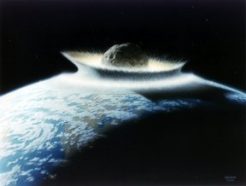Killer space rock snuffed out ancient life
Rock fragments from Antarctica suggest a huge meteor struck Earth 250 million years ago.
By Emily Sohn
Scientists are already pretty sure that a huge meteor wiped out dinosaurs 65 million years ago. There’s some evidence from China, Japan, and other places suggesting that a similar impact may have occurred 250 million years ago.
 |
|
A huge asteroid or meteor strikes Earth in this artist’s impression of what such an impact might have looked like.
|
| Don Davis/NASA |
The newest evidence comes from Antarctica. Researchers at the University of Rochester in New York used magnets and other equipment to extract pieces of metal and minerals from Antarctic dirt that is 250 million years old.
Analyses showed that particles in the dirt must have come from outer space. Amounts of iron, nickel, and other materials exactly match the composition of a type of meteorite that formed about 4.5 billion years ago. That’s around the time that our solar system was born.
The discovery doesn’t necessarily prove that a meteor caused mass extinctions 250 million years ago. It only shows that they happened at around the same time. Still, it now seems clear that big meteors can spell big trouble for life on earth. Luckily for us, such collisions are extremely rare
Going Deeper:
Perkins, Sid. 2003. Pieces of a pulverizer? Sediment fragments may be killer space rock. Science News 164(Nov. 22):323-324. Available at http://www.sciencenews.org/20031122/fob2.asp .
Information about asteroid and comet impact hazards can be found at impact.arc.nasa.gov/ (NASA).
You can find out more about how a meteor might have caused dinosaur extinctions at www.jpl.nasa.gov/earth/features/chicxulub.cfm (NASA).







